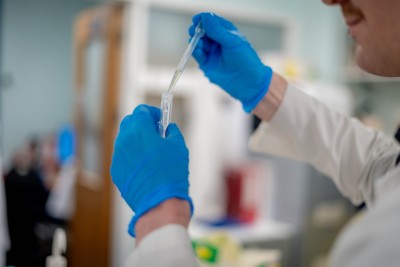
Chesterfield Royal Hospital
Staff from wards and departments can collect containers from Pathology Reception at any time during normal reception opening hours (Mon-Fri 08:30-17:00).
Needles and needle holders must be signed for and will be cross-charged to the Department concerned.
All supplies should be ordered using the correct order forms. These should be sent to Pathology Reception through the van collection service if possible. Needles and needle holders will be charged to the appropriate Primary Care Trust.
The form allows users to request the actual number of consumables:
• Blood bottles in multiples of 100
• MSU containers in multiples of 50
• Needles in multiples of 48
*So the system is not overloaded please order a minimum of a month's supply of all containers at the same time.
- Code - Container type
- Citrate- Blue (2.7ml) topped vacutainer
- Cross - Pink (6ml) topped vacutainer
- EDTA - Pale Purple (3ml) topped vacutainer
- Hep - Green (4ml) topped vacutainer Lithium Heparin
- Plain - Red (6ml) topped vacutainer
- Yellow - Yellow (6ml) topped vacutainer
- Fl - Grey (2ml) topped vacutainer Fluoride Oxalate
- Trans - Amies Transport swabs
*Volumes are shown on the label
- 24hr U - 24hr urine container please contact Pathology reception.
- EMU - Large sterile plastic container 250 ml for AFB urines
- Form - Formalin - see Histology section for full details
- Spe - Special container please contact Pathology reception.
- Univ - Sterile Universal 30 ml
- WM - Wide-mouthed container 60 ml
- UM - Urine Monovette tube
- Chlam - Special swabs available from the laboratory
Any person requesting examination of clinical specimens will, for the purpose of the Health & Safety at Work Act, be assumed to have read the following instructions.
Appropriate clinical details and in addition, Danger of Infection (High Risk) stickers MUST be attached to the sample container, the request form and the sample bag for any specimen in the following categories:-
(a) A specimen which may contain MYCOBACTERIA (ACID FAST BACILLI)
(b) All specimens from:-
- Known or suspected cases of infection by either blood-borne hepatitis viruses or HIV.
- Groups who have a higher than average incidence of infection by blood-borne hepatitis viruses and/or HIV.
(c) ANY OTHER SPECIMENS from known or suspected cases of infection with hazard group 3 micro-organisms, or where the handling of such specimens by laboratory staff carries a significant risk of infection – please refer to circular “Safety on Transmission of Pathology Specimens”
As a minimum precaution, all samples should be transported to the laboratory in the special biohazard bags:
The sample should be placed in the sealed compartment and the form in the open pocket so that the patient details are visible.
Samples transported by road must be in a suitable container that will contain them during any type of impact. The term “CE-marked leak-proof container” is used to describe containers bearing the CE marking used for the collection and transport of clinical specimens. The requirements for specimen containers are given in the EU in vitro Diagnostic Medical Devices Directive (98/79/EC Annex 1 B 2.1) which states: “The design must allow easy handling and, where necessary, reduce as far as possible contamination of, and leakage from, the device during use and, in the case of specimen receptacles, the risk of contamination of the specimen. The manufacturing processes must be appropriate for these purposes”.
Known High-Risk samples must NOT be transported in the pneumatic air tube
The concept of the ‘normal range’ has in many instances been misleading. The term is now technically obsolete and has been replaced by the “reference interval” commonly referred to as the “reference range”.
The change in terminology is intended to reflect the increasing awareness of changes in physiological and pathological processes and the need for an adequate description of individuals used for obtaining reference values and of analytical methods used.
In the hospital, it is usually remembered that age and gender are important factors in the interpretation of data, but other factors may be equally or more important, such as time of specimen collection, intake of food and drugs, posture, degree of obesity, gender status, pregnancy or stage of menstrual cycle. The method of specimen collection (e.g. venous stasis) and the analytical method used will, in many cases, influence the result obtained. It is impossible in this booklet to indicate all the effects of such factors on reference ranges.
For these reasons, reference ranges are not included in this booklet. Instead, most reports indicate the reference range for the test being measured and the range quoted in the report will be the correct reference range for the laboratory at that time. When age and gender are given on the request form the laboratory report will show the reference range appropriate to age and gender.
More detailed information on individual tests can be obtained from the laboratory.
Chesterfield Royal Hospital uses ICE request forms, hospital pathology general, Blood Bank antenatal, Group and Save, Cross Match and Histology specific request forms.
GPs have access to ICE.
Community midwives are supplied with Blood Bank antenatal request forms. The request form is considered an agreement to perform the requested tests either on-site or at an approved Referral Laboratory as indicated in the Test List (section 16) providing the acceptance criteria is met.
PLEASE REMEMBER
Inadequate information on your request form makes it impossible to issue a report or contact the doctor in the case of unexpected results. All requests must include the patient's surname, forename, Date of Birth and a unique ID (NHS, Hospital or ED number).